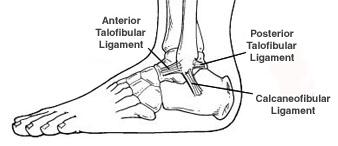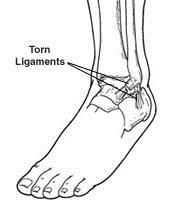Ankle Sprain
Ankle sprains are caused by an unnatural twisting or force on the foot, which may stretch or tear of one or more ligaments on the of the ankle. If not properly treated, ankle sprains may develop into long-term problems. Symptoms of ankle sprains are pain, swelling, and bruising.
What Is an Ankle Sprain?
An ankle sprain is an injury to one or more ligaments in the ankle, usually on the outside of the ankle. Ligaments are bands of tissue – like rubber bands – that connect one bone to another and bind the joints together. In the ankle joint, ligaments provide stability by limiting side-to-side movement.
Some ankle sprains are much worse than others. The severity of an ankle sprain depends on whether the ligament is stretched, partially torn, or completely torn, as well as on the number of ligaments involved. Ankle sprains are not the same as strains, which affect muscles rather than ligaments

Causes
Sprained ankles often result from a fall, a sudden twist, or a blow that forces the ankle joint out of its normal position. Ankle sprains commonly occur while participating in sports, wearing inappropriate shoes, or walking or running on an uneven surface.
Sometimes ankle sprains occur because of a person is born with weak ankles. Previous ankle or foot injuries can also weaken the ankle and lead to sprains.
Symptoms
The symptoms of ankle sprains may include:
- Pain or soreness
- Swelling
- Bruising
- Difficulty walking
- Stiffness in the joint

These symptoms may vary in intensity, depending on the severity of the sprain. Sometimes pain and swelling are absent in people with previous ankle sprains. Instead, they may simply feel the ankle is wobbly and unsteady when they walk. Even if there is no pain or swelling with a sprained ankle, treatment is crucial. Any ankle sprain – whether it’s your first or your fifth – requires prompt medical attention.
Why Prompt Medical Attention Is Needed
There are four key reasons why an ankle sprain should be promptly evaluated and treated by a foot and ankle surgeon:
- An untreated ankle sprain may lead to chronic ankle instability, a condition marked by persistent discomfort and a “giving way” of the ankle. Weakness in the leg may also develop.
- A more severe ankle injury may have occurred along with the sprain. This might include a serious bone fracture that, if left untreated, could lead to troubling complications.
- An ankle sprain may be accompanied by a foot injury that causes discomfort but has gone unnoticed thus far.
- Rehabilitation of a sprained ankle needs to begin right away. If rehabilitation is delayed, the injury may be less likely to heal properly.
Treatment includes rest and elevate the ankle and apply ice to reduce swelling. A compressive ace-wrap may help to immobilize and support the injury during healing. Serious ankle sprains, particularly among competitive athletes, may require surgery to repair and tighten the damaged ligaments.
To prevent ankle sprains, try to maintain strength, balance, and flexibility in the foot and ankle through exercise and stretching, and wearing well-fitted shoes. Physical therapy may be helpful after an injury has healed to strengthen the weak ankle and prevent from reoccurring.
